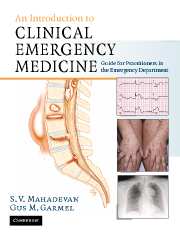Book contents
- Frontmatter
- Contents
- List of contributors
- Foreword
- Acknowledgments
- Dedication
- Section 1 Principles of Emergency Medicine
- Section 2 Primary Complaints
- 9 Abdominal pain
- 10 Abnormal behavior
- 11 Allergic reactions and anaphylactic syndromes
- 12 Altered mental status
- 13 Chest pain
- 14 Constipation
- 15 Crying and irritability
- 16 Diabetes-related emergencies
- 17 Diarrhea
- 18 Dizziness and vertigo
- 19 Ear pain, nosebleed and throat pain (ENT)
- 20 Extremity trauma
- 21 Eye pain, redness and visual loss
- 22 Fever in adults
- 23 Fever in children
- 24 Gastrointestinal bleeding
- 25 Headache
- 26 Hypertensive urgencies and emergencies
- 27 Joint pain
- 28 Low back pain
- 29 Pelvic pain
- 30 Rash
- 31 Scrotal pain
- 32 Seizures
- 33 Shortness of breath in adults
- 34 Shortness of breath in children
- 35 Syncope
- 36 Toxicologic emergencies
- 37 Urinary-related complaints
- 38 Vaginal bleeding
- 39 Vomiting
- 40 Weakness
- Section 3 Unique Issues in Emergency Medicine
- Section 4 Appendices
- Index
12 - Altered mental status
Published online by Cambridge University Press: 27 October 2009
- Frontmatter
- Contents
- List of contributors
- Foreword
- Acknowledgments
- Dedication
- Section 1 Principles of Emergency Medicine
- Section 2 Primary Complaints
- 9 Abdominal pain
- 10 Abnormal behavior
- 11 Allergic reactions and anaphylactic syndromes
- 12 Altered mental status
- 13 Chest pain
- 14 Constipation
- 15 Crying and irritability
- 16 Diabetes-related emergencies
- 17 Diarrhea
- 18 Dizziness and vertigo
- 19 Ear pain, nosebleed and throat pain (ENT)
- 20 Extremity trauma
- 21 Eye pain, redness and visual loss
- 22 Fever in adults
- 23 Fever in children
- 24 Gastrointestinal bleeding
- 25 Headache
- 26 Hypertensive urgencies and emergencies
- 27 Joint pain
- 28 Low back pain
- 29 Pelvic pain
- 30 Rash
- 31 Scrotal pain
- 32 Seizures
- 33 Shortness of breath in adults
- 34 Shortness of breath in children
- 35 Syncope
- 36 Toxicologic emergencies
- 37 Urinary-related complaints
- 38 Vaginal bleeding
- 39 Vomiting
- 40 Weakness
- Section 3 Unique Issues in Emergency Medicine
- Section 4 Appendices
- Index
Summary
Scope of the problem
The patient with altered mental status (AMS) represents a great challenge for emergency physicians: potential life threat, rapid decision-making and astute detective work. The etiology might be chronic or acute, life-threatening or benign, reversible or irreversible. One of nearly a dozen different organ systems might be implicated or perhaps harmed by the event. The knowledgeable, diligent emergency physician will be able to narrow the differential to a manageable number of diagnoses within minutes and correctly treat the majority of patients.
Terminology
AMS is an alteration of a patient's level of cognitive (knowledge-related) ability, appearance, emotional mood, and speech and thought patterns.
Level of consciousness relates to one's level of awareness and responsiveness to his or her surroundings.
Lethargy is generally referred to when one is suffering from a mild to moderate depression in level of consciousness. It implies an abnormal state of drowsiness or sleepiness in which it may be difficult to arouse the patient.
Stupor is a more profound depression of one's level of consciousness. One might say that stupor is an extreme form of lethargy requiring a greater stimulus to produce a lesser degree of arousal.
Coma is an abnormal state of deep unconsciousness from which a patient cannot be awakened.
Organic illness refers to impairment of normal anatomic and/or physiological activity resulting in impaired mental functioning. Functional illness generally refers to a physical disorder with no known or detectable organic basis to explain the symptoms.
- Type
- Chapter
- Information
- An Introduction to Clinical Emergency MedicineGuide for Practitioners in the Emergency Department, pp. 179 - 192Publisher: Cambridge University PressPrint publication year: 2005

